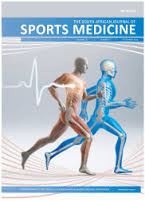The Isokinetic Rugby Union Physical Work Evaluation (RUPWE) protocol: Can Rugby Union Players meet the physical work demands of the game?
DOI:
https://doi.org/10.17159/2078-516X/2021/v33i1a8686Abstract
Background: To protect the lumbar spine from excessive forces, rugby union players need to demonstrate the work ability of the trunk extensors and flexors to meet the physical demands.
Aim: To measure and evaluate whether rugby union players were able to meet the imposed physical work demand, considering limitations, tolerances and resistance to fatigue, using isokinetic dynamometry for trunk extensors (TE) and trunk flexors (TF).
Methods: Fifty-five male players, between the ages of 18 and 23 years, participated in the study. All participants completed a PAR-Q (pre-activity risk) questionnaire before the isokinetic testing. Their height was between 1.80 ± 0.67 m and body mass was 86.0 ± 17.5 kg. Participants were subjected to a newly designed protocol using the Biodex Isokinetic System 3 Dynamometer, called the Rugby Union Physical Work Evaluation (RUPWE).
Results: There was a significant difference between the forwards’ trunk extensor peak torque to body weight 488% ± 119% and the trunk flexor peak torque to body weight 289% ± 73%. Furthermore, there was a large effect size between trunk extensor and trunk flexor muscle performance for the forwards (d =2.0) and backs (d =1.9) for peak torque to body weight. Spearman’s rank-order correlations (rs) showed a moderate negative correlation for the forwards between trunk extensor peak torque to body weight and time to peak torque, (rs = -0.4; p=0.018). There is a strong negative correlation for the backs between trunk extensor peak torque to body weight and time to peak torque, (rs = -0.6; p=0.003).
Conclusion: The physical work evaluation protocol can be used as a screening tool for rugby players as it measures the extensive mechanical load placed on the lumbar region. This has the potential to evaluate their athletic performance for the demands of tackling and scrumming.
Downloads
Downloads
Published
Issue
Section
License
The South African Journal of Sports Medicine reserves copyright of the material published. The work is licensed under a Creative Commons Attribution 4.0 (CC BY 4.0) International License. Material submitted for publication in the South African Journal of Sports Medicine is accepted provided it has not been published elsewhere. The South African Journal of Sports Medicine does not hold itself responsible for statements made by the authors.
How to Cite
- Abstract 979
- PDF 615





.png)